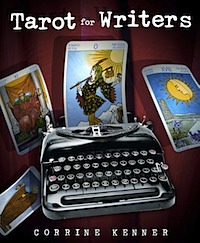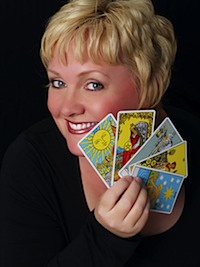By Melanie Harris
It takes a person with an unusual spectrum of experience to write a book like Corrine Kenner’s latest, Tarot for Writers (Llewellyn Worldwide, 2009). Raised on a farm in North Dakota and now making a living making sense of the esoteric, Corrine Kenner is a path maker on the road less traveled. As a teenager, she started writing professionally, honing her craft as a newspaper reporter and magazine editor. She earned a degree in Philosophy from California State University, yet her path led elsewhere, further into the field of writing and more deeply into her passion for Tarot. Carving her own niche as an “occult” writer with her very open and practical approach to the mystical, Corrine has authored over a dozen books, including the 2006 COVR awards finalist Tall Dark Stranger. And this certified Tarot master still finds time to regularly offer Tarot classes, workshops, and readings both online and from her office in Minneapolis.
When we heard about Tarot for Writers due out this February, we knew it would be something special. This book combines two of Corrine’s greatest passions—Tarot and writing—in a way that shares a fresh perspective with tarotist, writer, and Tarot-reading writer alike. Naturally, we had to learn more.
Tarot Reflections: Your new book Tarot for Writers explains techniques for using the Tarot to unlock creativity and gain inspiration in one's writing. Can you describe how the Tarot has helped you in your own writing?
Corrine Kenner: Tarot cards have really freed my imagination. It’s odd, because I’ve always been a writer — but I never used to think of myself as a “creative” writer. In fact, for most of my career, I dealt strictly with non-fiction. I started as a journalist, writing newspaper and magazine articles that were solidly grounded in facts, figures, and first-hand experience. Fiction writing seemed foreign to me: I just wasn’t comfortable making things up. Tarot cards helped bridge the gulf between my rational and intuitive sides. It’s almost as though Tarot cards have given me permission to report stories from my imagination.
TR: How long have you been using these techniques, and how did you develop them?
CK: Seven or eight years ago, I started bringing Tarot cards to my writers group. At that point, I’d always heard that Tarot cards were a great tool for creative writing, but I didn’t know of any proven techniques — so we improvised. Everyone would pull a card, and we’d use them to write a story as a group. Over time, we came up with variations on the theme, like pulling separate cards for every character in a story, or new cards for each scene.
The whole time our group was playing with the cards, I kept hoping I’d run across a comprehensive guide to Tarot for writers. I wanted something systematic and complete. Eventually, I realized that I’d have to write that book myself.
TR: Did the Tarot help you with the writing and submission process for this particular book?
CK: Yes. In fact, I was nervous about writing sample stories and paragraphs to demonstrate my techniques. I’m not known for my fiction, after all, and I wasn’t sure my creative writing would be good enough for the whole world to see. As it turned out, the examples seemed to write themselves. Once I let myself go and trusted the cards, they did all the work. Now I think the sample pieces are some of the best passages in the book.
TR: Is this book for Tarotists, or writers, or both?
CK: While I think Tarot for Writers will appeal to Tarot enthusiasts, I designed the guide with other writers in mind. The first chapter offers a very basic introduction to the cards, to acquaint beginners with the history and tradition of Tarot. Then the book moves into a series of step-by-step guides to using Tarot cards to create characters, storylines, and scenes, along with ideas for dialogue and description. There’s a chapter on using astrology with the cards, because that’s such an effective way to develop characters. I explore the similarities between the Fool’s Journey and the Hero’s Journey, which is a popular story model. There’s even a chapter on using Tarot cards as a creative writing coach.
TR: How does Tarot differ as a tool for writing, compared to its more common use as a tool for divination?
CK: There’s a surprising difference between teaching Tarot for writing and teaching a basic Tarot class. Most beginning Tarot readers have a student mentality, and they expect a lot of guidance and advice in their interpretations of the cards. Writers, on the other hand, don’t seem to worry about being right or wrong. They tend to use the cards strictly as a springboard for their own ideas and impressions — which is how experienced Tarot readers use the cards, too. While the book is designed more for writers than for Tarot readers, those Tarot readers who have seen it already all say, “This could really help people learn the cards.” That’s because there’s less pressure in writing about Tarot cards than in reading them aloud for other people.
TR: What's one way the Tarot can be used to move past writer’s block?
CK: There are so many ways, it’s hard to pick just one. At its most basic, Tarot cards simply give you something to write about. When you’re looking at a Tarot card, you’re not looking at a blank piece of paper: you can spot characters, stories, dialogue, and description, all in a single image. It’s very easy to start writing, just by describing the picture. Before long, almost magically, the characters in the card will start to move, to speak, to take action … and a story unfolds. Writing with Tarot cards is like watching a movie in your mind’s eye.
After all the time I’ve spent using Tarot cards with other writers, I still get chills to see how well these techniques work. Writers get flashes of insights into their characters, and they see their stories come to life. To tell you the truth, it’s spooky. It makes you wonder how many stories we all have buried in our subconscious minds.
TR: What do you think is one of the most common mistakes people make in their writing?
CK: Most writers worry too much about being good. The first step in writing is just to get your ideas down on paper, in any form. Random words and sentence fragments are fine. Incomplete thoughts and crazy tangents are perfectly okay. In fact, the first draft is never good, but most people get frustrated, because the written word seems so permanent. If you’re just starting to write, don’t worry about being perfect. Don’t even worry about being good. Just write, and know that you can always rework a piece after you’ve finished a first draft.
TR: Can hobbyist writers benefit from using the Tarot, or is this book geared toward professionals?
CK: Both groups can benefit, because the writing process is the same for amateurs and professionals alike. Nobody sits down and says, “I’m about to write a masterpiece.” Whether you’re working on a novel, a short story, or a newspaper report, the procedure is always the same: you research, you brainstorm, you develop a structure and a theme, and then you put words on paper. You start with the tiny seed of an idea, and then you write, rewrite, revise, and polish. Throwing Tarot into the mix can make all of those steps easier.
TR: There are so many uses for the Tarot, from divination, to, as described in your book, improving one's writing. What are some of your favorite ways to use the Tarot, and do you think when the Tarot was originally designed, that it was intended to be such a versatile tool?
CK: I use the cards in a number of ways, including divination, meditation, and creative inspiration. I’ve even played the card game of Tarot — just to get a sense of the designers’ original intent, hundreds of years ago in Italy and France. That’s because Tarot may have originated as a game, but as people played with the cards, it developed into something much, much bigger. Whether you read Tarot for someone else or use them for writing, the cards are always a vehicle for storytelling. The stories can be real or imagined, but Tarot always tells a tale.
TR: The Tarot can open our intuitive faculties and help us access our subconscious minds. What do you think is the difference exactly between a "normal" state of consciousness, and a heightened, intuitive state of consciousness?
CK: There’s a close similarity between a good Tarot reading and a good writing session. When I give a good Tarot reading, it’s as though images and ideas flow through me, rather than from me — and when I have a good session at the computer, writing, the same thing happens. I think Tarot cards are an easy way to open yourself to information, both from within and from the world around you. After a while, the cards help you slip into that heightened state of consciousness quickly and easily.
TR: What's next for you? Any upcoming books in the works after this one?
CK: I’m working on a new deck and book set called the Wizards Tarot, with art by John Blumen. The deck is designed to reflect life at a magic school called Mandrake Academy. All of the Major Arcana cards depict professors at the school, and the accompanying guidebook will offer brief lessons in the subjects they teach. The High Priestess, for example, is the professor of divination, so her chapter covers the art of reading Tarot cards. Meanwhile, the Minor Arcana cards show students practicing fire, water, air, and earth magic, and that section of the guidebook reads like a grimoire or a book of shadows — complete with charms, spells, and magic potions for every card. The court cards turned out really well; they depict the elemental creatures of fire, water, air, and earth, as humanized salamanders, undines, sylphs, and gnomes. They are elemental royalty, and it’s their role to assist, protect, and guard the students and faculty at the school. I’m thrilled at how the deck is coming along, and I’m already writing fiction based on those characters. [You can get a preview of the Wizards Tarot at www.wizardstarot.com.]

